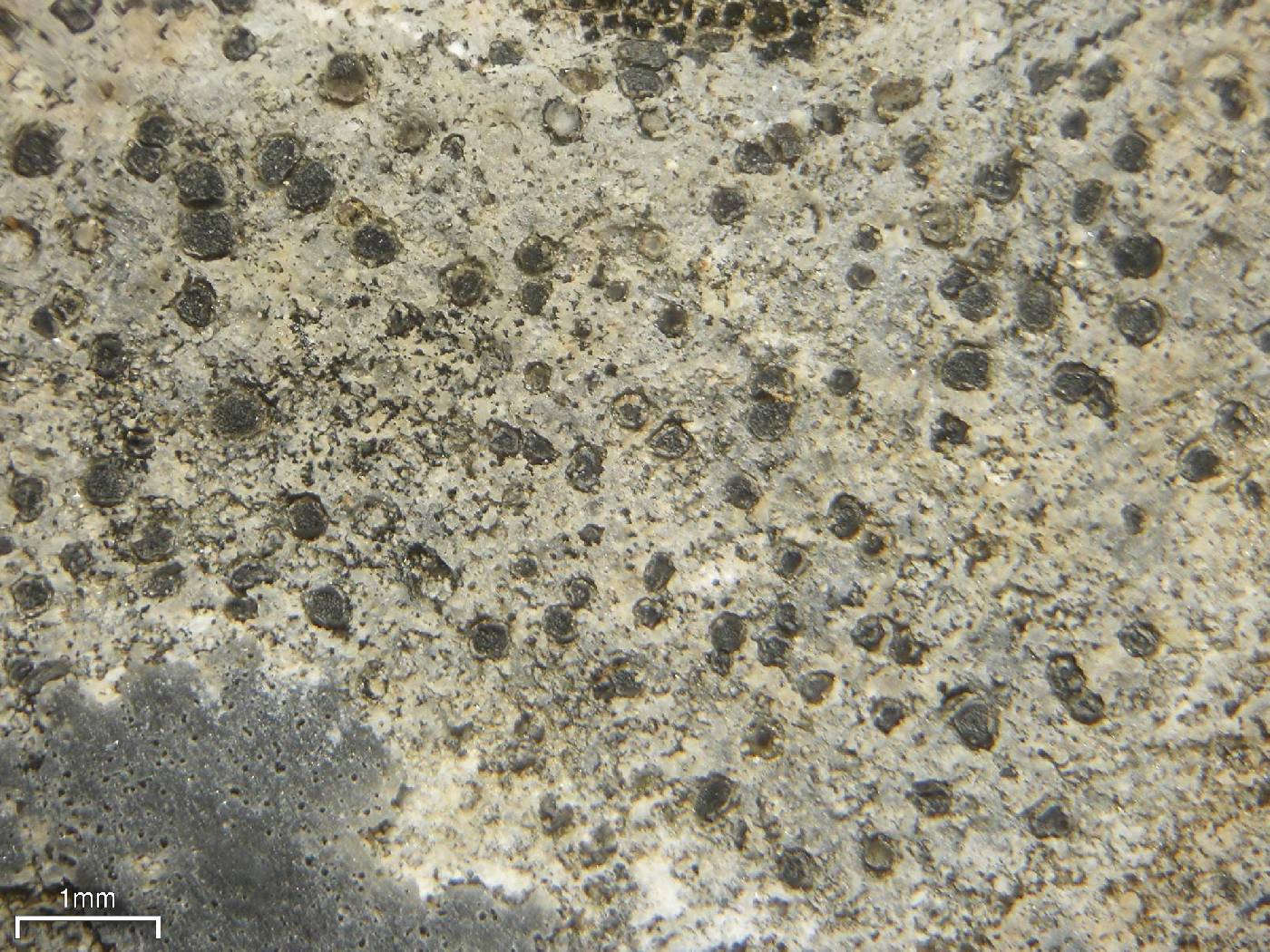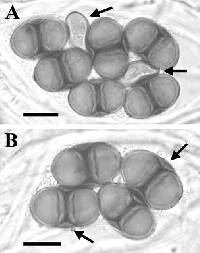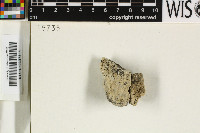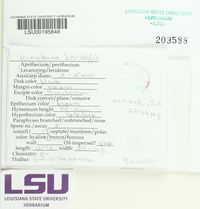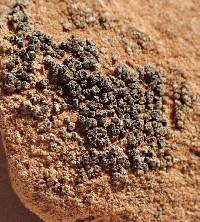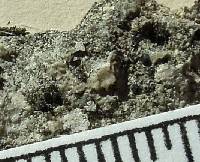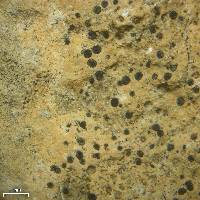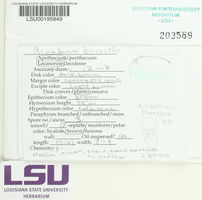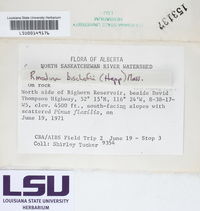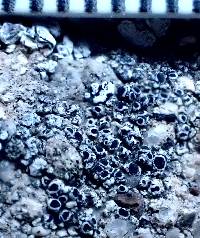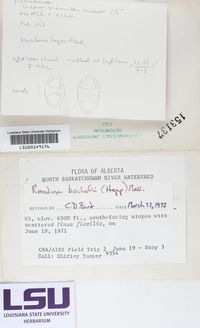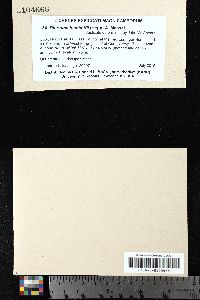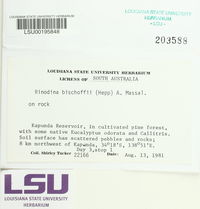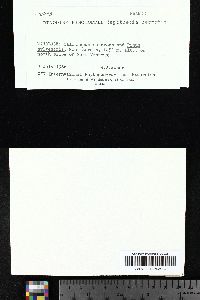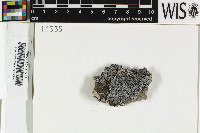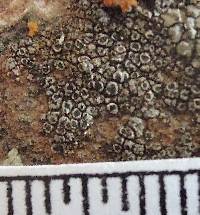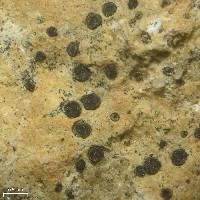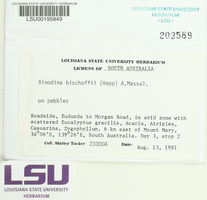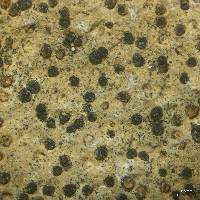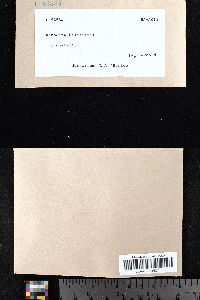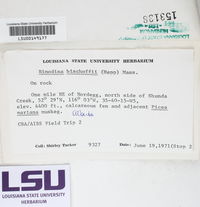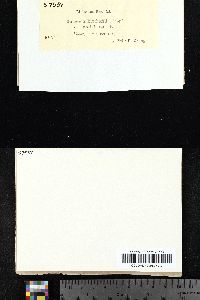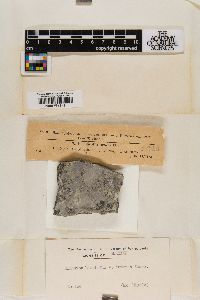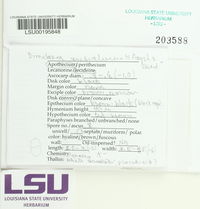
- Home
- Search
- Images
- Species Checklists
- US States: O-Z >
- US National Parks
- Central America
- South America
- US National Parks
- Southern Subpolar Region
|
|
|
|
Family: Physciaceae
[Berengeria bischoffii (Hepp) Trevis., moreLecanora bischoffii (Hepp) Nyl., Lecidea alociza Cromb., Microthelia leightonii Zahlbr., Parmelia bischoffii (Hepp) Lönnr., Psora bischoffii Hepp, Rinodina bischoffii subsp. immersa (Körb.) Arnold, Rinodina bischoffii var. immersa Körb., Rinodina immersa (Körb.) Zahlbr., Rinodina immersa f. immersa (Körb.) J. Steiner, Rinodina penaridiana] |
MB#404239 Basionym. Psora bischoffii Hepp Flechten Europas 81 (1853). Rinodina immersa (Körb.) Zahlbr., Sitzungsber. Kaiserl. Akad. Wiss., Math.-Naturwiss. Cl., Abt. 1 115: 522 (1906). Exsiccatae. Arnold Lich. Monac. Exs. 98 (BM as R. subconfragosa Nyl.); Cummings Decades North Amer. Lich. 192 (MU, WIS); Hepp Flechten Eur. 411 (NY as Psora bischoffii $ confragosa); Migula Krypt. Germ. Exs. Flechten 146 (NY as R. immersa). Description. Thallus endolithic, inconspicuous and present only around apothecium base, or epilithic, thin, rimose, plane; surface dark grey, matt; margin indeterminate; prothallus lacking; vegetative propagules absent. Apothecia frequent, rarely contiguous, immersed in substrate or narrowly attached, to 0.35-0.50 mm in diam.; disc black, rarely pruinose, plane, often becoming convex or half‑globose; thalline margin concolourous with thallus or partially concolourous with disc, 0.05-0.10 mm wide, entire, frequently becoming excluded; excipular ring sometimes present, confluent. Apothecial Anatomy. Thalline exciple 60-110 µm wide laterally; cortex absent or to 10-20 µm wide; epinecral layer usually absent; crystals absent in cortex and medulla; cortical cells to 5.5-6.5 µm wide, pigmented; algal cells to 10.0-14.5 µm long; thalline exciple 50-120 µm wide below; cortex not expanded; proper exciple hyaline, 10-15 µm wide laterally, 20-40(-75) µm at periphery; hypothecium hyaline, 50-100 µm deep; hymenium 100-130 µm high, inspersed or not; paraphyses ca. 2.0 µm wide, not conglutinate, with apices to 5.0-6.5 µm in diam., heavily pigmented, forming a brown or reddish brown epihymenium; asci clavate, 50-90 x 16-22 µm. Ascospores 8/ascus, Type A development, Bischoffii-type (Figure 23), (14.5-)16.5-18.0(-20.0) x (8.0-)10.0-11.5(-13.0) µm, average l\b ratio 1.5-1.8, lumina rounded at apices from start, broad canal sometimes becoming excluded, typically with broad pigmented band around septum; torus absent; walls not ornamented. Pycnidia immersed, pigmented ostiole protruding from thallus; conidiophores Type VI; conidia sparsely produced, bacilliform, often with persistent attachment point, 3.5-5.5 x 1.0 µm. Chemistry. Spot tests all negative; secondary metabolites not detected. Substrate and Ecology. Recorded on limestone and calcareous sandstone, at elevations of 680-3 075 m although elevations are rarely recorded except in the western mountains. Distribution. This species possesses a widespread, temperate distribution in North America but is apparently absent from the Pacific Northwest and southeastern states, perhaps partly due to a lack of suitable substrates. Elsewhere, it is known in Europe from the Arctic Circle to North Africa, South Africa, Asia, Australasia (Kaschik 2006). Notes. The species is very variable with respect to external morphology, the thallus ranging from being relatively well developed with narrowly attached apothecia to entirely endolithic with the apothecia immersed in the substrate. This latter morphotype usually has been treated as a separate species, R. immersa (Mayrhofer 1984, Giralt 2001, Mayrhofer & Moberg 2002), on the grounds that the hymenium consistently lacks oil droplets. However, many examples of the bischoffii-morphotype with little or no inspersion, and also of the immersa-morphotype possessing some inspersion can be found, so the two forms intergrade in this respect. The two morphotypes sometimes are found side by side without intermediate forms. Sheard (1967) observed that in such cases the different morphotypes were found on different substrate textures, the form with immersed apothecia being found on softer substrates. The juxtaposed morphotypes therefore may be growing in different micro-environments and may not reflect different genotypes. There is clearly a need for detailed ecological and anatomical studies to fully resolve these issues. Rinodina bischoffii is closely related to R. guzzinii which differs in the better developed thallus, and its significantly larger, parallel sided spores. In the arctic and Canadian Rocky Mountains the species might be confused with R. calcigena which generally has larger spores in which the canals quickly becomes excluded and which may only have a faint pigmented band around the septum. This species also has larger, always narrowly attached, very symmetrical apothecia with inspersed hymenia. Rinodina castanomelodes is another very closely related species (treated as a variety of R. bischoffii by Giralt 2001) which is distinguished primarily by the much better developed, almost subsquamulose, thallus and large apothecia, approaching the general habit of R. castanomela. Nevertheless, forms of R. castanomelodes with poorly developed thalli are easily confused with well developed thalli of R. bischoffii but can be distinguished by the parallel sided rather than ellipsoidal spores characteristic of R. bischoffii at maturity. Rinodina penardiana Müll. Arg. was listed as a synonym of R. bischoffii by Weber and Wittman (1992) but the holotype (G) belongs to an Amandinea or Buellia species. Specimens examined. CANADA. ALBERTA. 1 mi NE Nordegg, J.W. Thomson 21493 (WIS); Cypress Hills Interprov. Park, P.A. MacNeil 4140 (PMAE); Greenock W.A. Weber 23372 (COLO); Kananaskis, I.M. Brodo 7551 (CANL); Wilcox Ridge, G.W. Scotter 7701 (CANL); NUNAVUT. Devon Island, A.I. Taylor 124 (WIS). N.W.T., Mackenzie District, Campbell Lake, G.W. Scotter 8194 (H); Little Gull River, G.W. Scotter 8362B (H). ONTARIO. Kenora District, East Pen Island, 1971, K.A. Kershaw (CANL). QUEBEC. Gatineau Co., King Mountain, I.M. Brodo 19078 (CANL). SASKATCHEWAN. IBP Matador Site, J.A. Jesberger 813 (SASK). YUKON. Ross River area, R. Rosie 885 (CANL). U.S.A. ALASKA. Umiat, J.W. Thomson 10254. ARIZONA. Coconino Co., 30 mi S Flagstaff, J.W. Thomson 18542 (all WIS); Grand Canyon Nat. Park, C.M. Wetmore 14929A (ASU, MIN); M. Boykin 2502, 2613 (ASU); Kaibab Nat. Forest, C.M. Wetmore 17121B (MIN); Gila Co., Tonto Nat. Forest, T.H. Nash 38621; Yavapai Co., 0.5 km N McGuirevill, T.H. Nash 34172, 39277; 13 km NW Camp Verde, T.H. Nash 34152 (all ASU). CALIFORNIA. Los Angeles Co., Santa Monica, H.E. Hasse (US); Topanga Canyon, 1907, H.E. Hasse (FH); Monterey Co., Carmel Valley, I. Tavares 912, 916, 933, 945 (UC); San Diego Co., San Diego, 1884, H.N. Bolander (FH); Santa Clara Co., Black Mountain, 1904, A.C. Herre (MIN); 1905, A.C. Herre (UC); 1932, A.C. Herre (NY). COLORADO. Boulder Co., 2 mi NW Lyons, R.A. Anderson 6166, 6169 (COLM); Boulder, W.A. Weber S2155 (US); Otero Co., Mindeman, S. Shushan S0162 (COLO). IDAHO. Bear Lake Co., 14 mi SE Montpelier, R. Rosentreter 7770 (personal herb.), 7770c (McCune personal herb.); Elmore Co., NW Mountain Home, B. McCune 19067 (personal herb.). ILLINOIS. Jackson Co., Devils Bake Oven, A.C. Skorepa 6208 (BALT); Kane Co., 1895, B. Fink (H, UPS); La Salle Co., Bailey's Falls, W.W. Calkins (NY); Union Co., Pine Hills, A.C. Skorepa 609 (WIS). IOWA. Fayette Co., 1893, B. Fink (FH, MIN); Fayette, 1893, B. Fink (MIN, NY, WIS); 1895, B. Fink (CANL, DUKE, FH, MICH, MIN, PH, US, WIS). KANSAS. Logan Co., Smoky Valley Ranch, C.A. Morse 12405 (KANU). MINNESOTA. Blue Earth Co., Mankato, 1899, B. Fink (MIN, US); Goodhue Co., Cannon Falls, C.M. Wetmore 21372; Polk Co., Trail, C.M. Wetmore 35665; Wabasha Co., 12 mi SE Wabasha, L. Brako 1463; Winona Co., 2 mi W Elba, L. Brako 2416; Beaver, L. Brako 2022; 10 mi NW Winona, L. Brako 915B. MISSOURI. Christian Co., Wilson's Creek Nat. Battlefield, C.M. Wetmore 76768, 76931 (all MIN). MONTANA. Beaverhead Co., Pioneer Mountains, B. McCune 20771 (personal herb.); Carter Co., 10 km W Alzada, B. McCune 13325 (SASK); Gallatin Co., Hyalite Canyon, B. McCune 25981 (personal herb.); Granite Co., Bear Creek, B. McCune 6520 (personal herb., WIS); Bearmouth, B. McCune 26010b; Jefferson Co., Jefferson Canyon, B. McCune 25953 (both personal herb.); Powder River Co., 17 km E Ashland, B. McCune 14485 (SASK); B. McCune 14480; Silver Bow Co., Maiden Rock, B. McCune 13527; Wallowa Co., Ice Lake, B. McCune 27926 (all personal herb.). NEBRASKA. Sioux Co., Agate Fossil Beds, C.M. Wetmore 76961, 77873 (MIN). NEW MEXICO. Bernadillo Co., Sandia Mountains, S.C. Tucker 37288A (SBBG); San Juan Co., J. Marsh 392 (ASU). NEW YORK. Albany Co., Ravina, I.M. Brodo 3476, 3484C (CANL); Erie Co., Buffalo, Wilson (US). NORTH DAKOTA. Billings Co., 2.5 mi N Medora, C.M. Wetmore 44936; 6 mi NNE Medora, C.M. Wetmore 80453; 35 mi NW Belfield, C.M. Wetmore 45302 (all MIN); S Unit Roosevelt Nat. Park, 1978, T.L. Esslinger 6848 (COLO); McKenzie Co., Watford City, C.M. Wetmore 44902A; Williams Co., Fort Union Trading Post, C.M. Wetmore 80251, 80262 (both MIN). OKLAHOMA. Murray Co., Turner Falls, J.W. Thomson 8680 (WIS). SOUTH DAKOTA. Custer Co., 16 mi W Custer, C.M. Wetmore 6760b (MSC); 4 mi W Custer, C.M. Wetmore 6695b (MSC, US); Schenk Canyon, C.M. Wetmore 11846 (DUKE, MSC); Hell Canyon, C.M. Wetmore 6918 (MSC); Lawrence Co., 5mi NW Spearfish, C.M. Wetmore 11213c (MSC); C.M. Wetmore 11229 (MIN); Pennington Co., Ditch Creek Campground, C.M. Wetmore 7647A (MSC, WIS); E Hayward, C.M. Wetmore 11040c (MSC); 15 mi SW Rapid City, C.M. Wetmore 11048 (CANL). TEXAS. Brewster Co., Big Bend Nat. Park, C.M. Wetmore 19307 (MIN). UTAH. Emery Co., 27 mi S Price, C.M. Wetmore 16518B (MIN); Uintah Co., Dinosaur Nat. Mon., R.A. Anderson 29427 (COLO); Utah Co., Provo Canyon, T.H. Nash (ASU); Wasatch Co., E Red Creek Peak, C. Newberry 1077 (BRY). VERMONT. Addison Co., Middlebury, E. Lay 0049 (personal herb.). WASHINGTON. Stevens Co., Kettle Falls, W.J. Eyerdam 3270 (DUKE). WISCONSIN. Dane Co., Wisconsin River, J.W. Thomson 1846 (WIS); Iowa Co., 6 mi W Arena, C.M. Wetmore 13168A (MIN); Richland Co., Port Andrews, K.G. Foote 60870A (WIS); Sauk Co., Wisconsin River Valley, 1968, F.H. Utech (SASK). WYOMING. Park Co., N. Clay Butte, B. McCune 19778 (personal herb.); Yellowstone Nat. Park, 1872, H. Willey (US); Weston Co., 20 mi NNW Newcastle, C.M. Wetmore 11245 (MSC, UPS). Selected References. Sheard (1967 Fig. 4), Wetmore (1968 including R. luridata), Mayrhofer & Poelt (1979 Abb.11 and as R. immersa), Mayrhofer (1984a Abb. 2c and 52 as R. immersa), Brodo (1988 Fig 28), Fox & Purvis (1992 Fig. 25j and also as R. immersa), Thomson (1997), Giralt (2001 Plate IX:C), Mayrhofer & Moberg (2002 p. 43, 101 and p. 104 as R. immersa), Thomson (2003), Sheard (2004 Fig. 63), Kaschik (2006 Fig. 4, Fig. 27 as R. immersa). Nash, T.H., Ryan, B.D., Gries, C., Bungartz, F., (eds.) 2004. Lichen Flora of the Greater Sonoran Desert Region. Vol 2. Thallus: crustose, endolithic, evanescent and present only around the base of apothecia, or thin and rimose, plane surface: dark gray, dull; margin: indeterminate; prothallus: lacking; vegetative propagules: absent Apothecia: frequent, rarely contiguous, immersed in substrate or sessile, up to 0.35-0.5 mm in diam. disc: black, plane, often becoming convex or half-globose thalline margin: concolorous with thallus or partially concolorous with disc, 0.05-0.1 mm wide, entire, frequently becoming excluded; excipular ring: sometimes present, confluent thalline exciple: 60-110 µm wide laterally; cortex: absent or cellular, 10-20 µm wide; cells: up to 5.5-6.5 µm wide, pigmented; algal cells: up to 10-14.5 µm in diam.; thalline exciple: 50-120 µm wide below; cortex: not expanded proper exciple: hyaline, 10-15 µm wide, 20-40(-75) µm at periphery hymenium: 100-130 µm tall, inspersed or not; paraphyses: c. 2 µm wide, not conglutinate, with apices up to 5-6.5 µm in diam., heavily pigmented, forming a dark brown epihymenium; hypothecium: hyaline, 50-100 µm thick asci: clavate, 50-90 x 16-22 µm, 8-spored ascospores: brown, 1-septate, broadly ellipsoid, type A development, Bischoffii-type, (14.5-)16.5-18(-20) x (8-)10-11.5(-13) µm, lumina rounded at apices from start, broad canal sometimes becoming excluded, typically with broad pigmented band around septum; torus: absent; walls: not ornamented (Fig. 63) Pycnidia: immersed, pigmented ostiole protruding from thallus; conidiophores: Type VI conidia: sparsely produced, bacilliform, often with persistent attachment point, 3.5-5.5 x 1 µm Spot tests: all negative Secondary metabolites: none detected. Substrate and ecology: on limestone and calcareous sandstone World distribution: Europe from the Arctic Circle to North Africa, Asia, Australia and New Zealand and widespread in North America but absent from the northern Coastal Ranges, Cascades and Sierra Nevada Sonoran distribution: southern California and Arizona at elevations of 680-1860 m. Notes: The species is very variable with respect to external morphology, the thallus ranging from being relatively well developed with sessile apothecia to entirely endolithic with the apothecia immersed in the substrate. This latter morphotype usually has been treated as a separate species, R. immersa (Giralt 2001, Mayrhofer 1984, Mayrhofer and Moberg 2002), on the grounds that the hymenium also consistently lacks oil droplets. However, many examples of the bischoffii-morphotype with little or no inspersion, and also of the immersa-morphotype possessing some inspersion can be found, so the two forms intergrade in this respect. The two morphotypes sometimes are found side by side without intermediate forms. Sheard (1967) suggested that the different morphotypes are the result of different substrate textures, the form with immersed apothecia being found on softer substrates. Such differences in texture occur on adjacent parts of the substrate and the juxtaposed morphotypes therefore may be growing in different environments. It follows that the two morphotypes may not reflect different genotypes. Rinodina bischoffii is closely related to R. guzzinii, that differs in the better developed thallus, and significantly larger, and parallel sided spores. |
|
|
|

